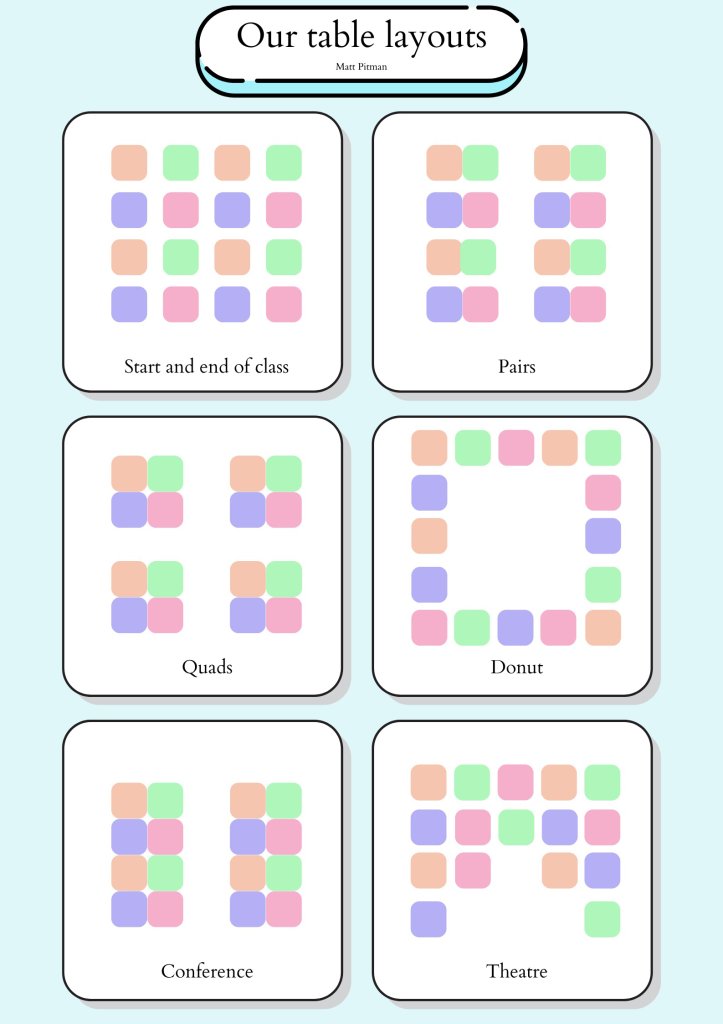Why My Classroom Furniture Never Stays Still for Long
Rearranging the desks and tables depending on the learning activity signals to students that they also need a shift in thinking.
Your content has been saved!
Go to My Saved Content.In my middle school and high school classrooms, tables slide, shift, and reconfigure as often as my students’ thinking. There’s no “best” arrangement, only the one that fits the learning.
Walk into a classroom, and one of the first things you’ll notice is the way the tables are arranged. Rows, clusters, circles—each setup promises to unlock a certain kind of learning. Search online, and you’ll find countless articles offering the “best” table arrangements for student success.
But after years of teaching, I can say with confidence: No one arrangement fits every lesson. In fact, in my classroom, tables never stay still for long. They’re constantly on the move—sliding, rotating, and shifting—as fluidly as the learning requires.
In my room, we don’t design our learning around the furniture—we design the furniture around the learning.
The case for individual space first
Each lesson in my classroom begins with a focus on individual thinking. Tables start in neat single rows. Every student has their own clearly defined space, a spot they can own, without the pressure or distraction of others. This space is supported by seating plans in each class, reducing the pressure of finding a seat and providing students with further sense of security and routine as they enter. It’s here that we launch into the initial phases of the lesson: direct instruction, modeling, and the first moments of independent practice.
This time is sacred.
Students need room to think, make mistakes, and build confidence on their own. They need to know it’s OK to struggle privately before being asked to collaborate publicly. A clear, personal space sends a simple but powerful message: Your thinking matters.
When the room comes alive
But then, almost like flipping a switch, everything changes. Once students have had a chance to grapple individually with the content, it’s time to deepen, extend, and broaden their understanding through collaboration. And this means movement, not just of minds, but of bodies and tables.
At this point, my classroom often looks like organized chaos. Tables slide into fours for small group discussions. Sometimes we form two big conference-style groups for class debates. Other times, we create tiny islands dotted around the room for project-based learning. On occasion, we even clear the tables entirely to give room for kinesthetic activities.
There’s no one-size-fits-all when it comes to these configurations. It depends entirely on the purpose of the task: Are students brainstorming? Peer reviewing? Solving a problem together? Presenting ideas?
The physical space must match the cognitive demand.
Rather than seeing this movement as disruptive, I see it as essential. Movement signals a shift in thinking. It tells students that a new phase of learning has begun. It energizes them. It keeps the classroom dynamic—a place where change is expected, welcomed, and productive.

Planning first, furniture second
A well-organized classroom is not about locking yourself into one arrangement that looks neat but feels stagnant. It’s about putting just as much thought into how students will interact with each other and the content as you do into what they will be learning.
Good routines make this possible. My students know that table moves are part of the flow of a lesson. We have quick, simple procedures: “Move into your quads,” “Conference setup,” “Project groups.” Within 30 seconds, the room transforms without a fuss. It’s not chaotic because it’s expected.
Planning for dynamic room use also means having clear learning intentions. If I know that my lesson requires a progression from personal reflection to small group critique, to a whole class synthesis, I plan my room shifts accordingly. I build these transitions into the rhythm of the lesson.
When I do this, the space becomes another tool in my teaching tool kit, as powerful as questioning techniques, scaffolds, or feedback strategies.
Why static rooms hold students back
When tables stay the same all day, every day, so too can the learning. A static room can send the message that learning is linear and predictable, when in fact it is dynamic and evolving.
Middle and high school students need both individual time and collaborative opportunities. They need to know when it’s time to focus inward and when it’s time to lean on and learn from their peers. The physical environment can and should support this journey.
Additionally, movement within a lesson offers an often-underrated benefit: engagement.
Quick shifts in physical space break the monotony and reset attention. They cater to different learning needs, encouraging students who may shine when working alone and others who flourish in a group.
It’s not about novelty for novelty’s sake. It’s about creating a responsive environment where the space reflects and enhances the learning experience.
The bottom line
There is no single “best” table arrangement. There is only what best suits the learning at that moment.
If we put as much intentionality into how we organize our room as we do into the activities we plan, we create classrooms that are not only more flexible but more alive.
We show students that learning isn’t static, and neither are we.
So, let the tables glide, pivot, and whirl. Let your room—and your students—move with purpose, energy, and joy.